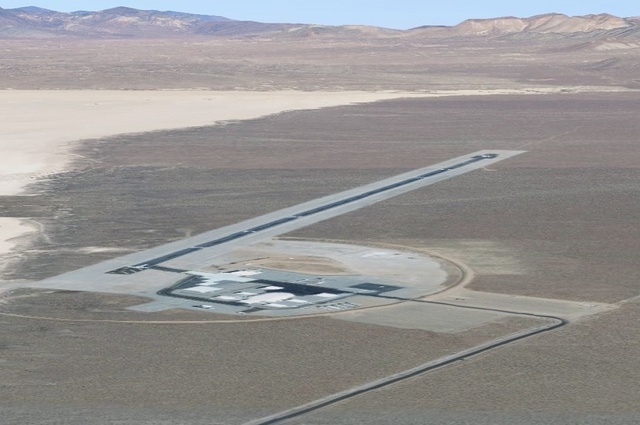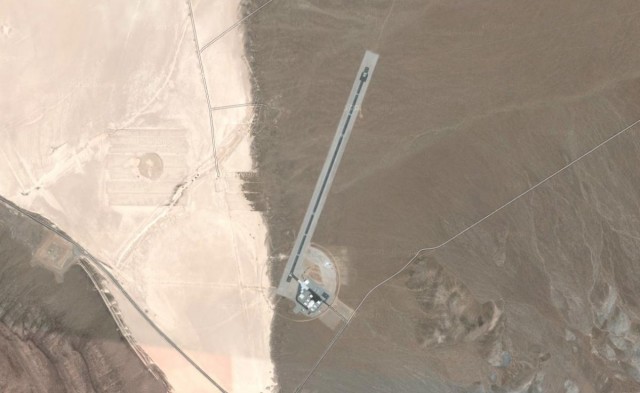The asphalt runway stretches for a mile on Yucca Flat, deep in the Nevada National Security Site about 80 miles northwest of Las Vegas. Built in 2005, the runway covers a dirt landing strip from the 1950s, when the wide, flat valley was used for atomic bomb test shots. A small complex of buildings dominated by a large hangar with unusual clamshell doors dominates the southern end of the asphalt strip.
The complex has no official name. Not many people even know it’s there.
As secret airbases go, the single runway in the test site’s Area 6 is easily overshadowed by the world’s most famous secret military base, Area 51, a dozen miles northeast. Area 51’s existence was only recently acknowledged, even after decades of speculation by UFO enthusiasts that the aircraft development and test facility also houses space aliens and extraterrestrial technology.
Unlike Area 51, which is protected by shoot-to-kill security and shielded from outside view by mountain ranges, Area 6 has only fences and visitor checkpoints. It can be seen at a distance from tour buses on the highway to historic bomb craters at the northern end of Yucca Flat.
But exactly what goes on at the much smaller and much newer Area 6 is still top-secret defense research-and-development work. It’s so hush-hush that the security site’s spokesman can say little about it.
Darwin Morgan, a spokesman for the National Nuclear Security Administration, said the low-key Area 6 facilities have been used by the Defense and Homeland Security departments.
“They come here to test their own sensors,” he recently said after spending months fending off questions about the Area 6 runway from the Review-Journal.
LITTLE-KNOWN OPERATION
Other than a few “Above Top Secret” forum posts from 2009, and a Wikipedia blurb that cites a 2011 Flightglobal story saying the runway is part of an unmanned aerial vehicle test facility, little has been written about the Area 6 runway.
Flightglobal, an aviation industry website, noted a five-sentence description of the Area 6 “aerial operations facility” found in a 7,500-page safety report on the proposed Yucca Mountain nuclear waste project.
“The purpose of this facility is to construct, operate, and test a variety of unmanned aerial vehicles. Tests include, but are not limited to, airframe modifications, sensor operation, and onboard computer development. A small, manned chase plane is used to track the unmanned aerial vehicles,” reads the report Energy Department contractor Bechtel SAIC prepared in 2008 for the Yucca Mountain repository license application.
The National Nuclear Security Administration is a semi-autonomous branch of the Energy Department. Its Nevada field office, based in North Las Vegas, runs the security site.
What it costs to operate Area 6 is difficult to determine. Funding is buried in the Nevada field office’s Strategic Partnership Program, which was part of the $84 million budgeted for the entire security site in fiscal year 2015. Program funding was about 13.5 percent of the field office’s $622 million total budget that year.
The program’s activities include research and development of sensors for detecting explosive materials, deadly gases and chemicals, and radioactive sources that could be used in “dirty bombs.”
Biological weapon sources aren’t allowed at the security site, according to its environmental impact statement.
Portable radiation monitors and some sensors used in airports and at ports of entry have evolved from the program.
Morgan said agencies in the Strategic Partnership Program take advantage of the security site’s restricted airspace to test sensor-equipped aircraft work without public interference or spying from space.
“We have controlled airspace and that gives them opportunities to test various types of platforms,” he said.
Most of the strategic partnership money comes from Defense Department branches: the Air Force, Army, Navy, Marines, Defense Threat Reduction Agency and the Defense Advanced Research Projects Agency.
“We do a wide variety of work for others … supporting people with sensor development activities,” Morgan said. “It evolved from the nuclear testing program. We had to have very good sensors to collect data in a split second before they were obliterated.”
Morgan said the Area 6 runway and its apron were built by Bechtel Nevada, the site’s management and operations contractor at the time, at a cost of $9.6 million. The buildings were constructed over several years, and cost figures aren’t immediately available.
As seen from above on Google Earth, the complex is dominated by the clamshell-door hangar and four smaller outbuildings connected by what appear to be covered walkways. Two smaller modern hangars and an older one used during atomic test days round out the facility. Morgan said antennas were installed to allow ground operators to control the flight of unmanned aerial system aircraft.
LOOKING FOR ‘EVILDOERS’
The National Nuclear Security Administration has kept Area 6 so low profile that even defense industry experts were unaware of it.
“I had not heard about it,” said John Pike, director of GlobalSecurity.org, an Alexandria, Va.-based defense information website.
But Pike’s associate, imagery analyst Tim Brown, has estimated the hangar complex could hold about 15 MQ-9 Reaper remotely piloted spy planes.
Pike said the length of the runway suggests Area 6 is used for small planes or remotely piloted aircraft such as Predator and Reaper reconnaissance drones.
Bigger spy planes, such as the jet-powered RQ-170 Sentinel unmanned aircraft system, are flown from the Tonopah Test Range by the 30th Reconnaissance Squadron assigned to a Creech Air Force Base wing. It’s unclear if the Sentinel or smaller versions would be flown from Area 6, but Pike said the runway is too small for large jets and bombers. Takeoffs and landings would be tight for an F-16, for example, and an F-15 would need an even longer strip for safe maneuvers.
Pike said aircraft likely in use at Area 6 are best suited for surveillance of hidden targets, weapons or personnel on the ground, particularly in sparsely populated areas. The security site’s high-desert terrain is similar to what might be found in the “boondocks” of Libya, he noted.
“There is a well-founded fear that evildoers are stalking around out there — ISIS and al-Qaida,” he said of Libya. “You have to imagine that trying to develop targeting signatures in this type of mountainous desert terrain. That’s got to be a really high priority … not constrained by funding.”
“I can’t think about a better place to do it where you wouldn’t have civilians stumbling on what you’re doing,” he said in reference to the security site.
So what would stray civilians see if they could stumble in?
Pike offers an educated guess: Sensor arrays made up of more than 350 smartphone cameras mounted on an MQ-9 Reaper that can record and archive movements of people and vehicles over an area of about 40 square miles.
It is known in the unmanned aerial vehicle community as the “Gorgon Stare,” derived from Gorgon monsters of Greek mythology whose gaze was so dreadful it was said to turn a person into stone. While the sensors can’t do that, they can keep terrorist targets from evading the sights of U.S. weapons.
According to the Defense Advanced Research Projects Agency website, sensor development has soared to new heights under ARGUS, or the Autonomous Real-time Ground Ubiquitous Surveillance program.
The goal is to “provide at least 130 independently steerable video streams to enable real-time tracking of individual targets throughout the field of view. The ARGUS-IR system will also provide continuous updates of the entire field of view for enhanced situational awareness,” the defense tech agency website says.
Pike said improving ARGUS and similar sensor capabilities might be among the activities taking place at Area 6.
“The thing you get with ARGUS is time-lapse photography. If there’s a rock out there that’s moving, maybe that’s a rock you ought to be paying attention to. Maybe it has to do with evildoers,” he said.
“I would assume they have airplanes and UAVs (unmanned aerial vehicles) they’re flying around out there to see what they can see,” Pike said.
“If they would let me run the thing, I’d tell (special operation troops) to go out and do the best in terms of infiltration,” he said. “Then turn loose the sensors and see if we could find them, play hide-and-seek.”
Source: Las Vegas Review Journal


